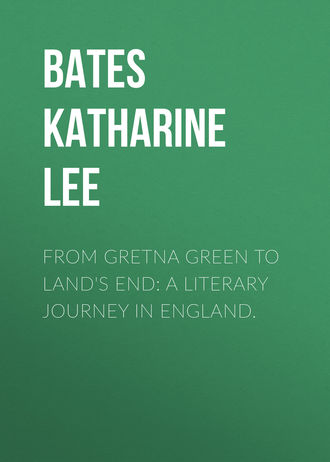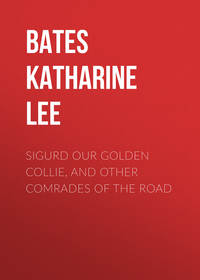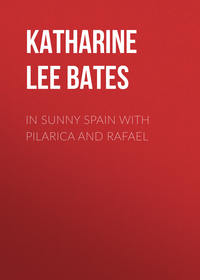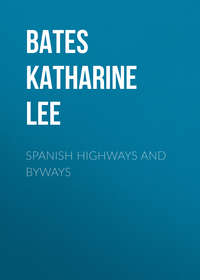 полная версия
полная версияFrom Gretna Green to Land's End: A Literary Journey in England.
On our way from the one to the other we passed through the mining town of Redruth, near which, in the hollow known as Gwennap Pit, Wesley addressed vast audiences. On one occasion the number was reckoned as thirty-two thousand. "I shall scarce see a larger congregation," he wrote, "till we meet in the air." The more mystical doctrines of Fox took little hold on the rough fishermen and miners of Cornwall, but Wesley practically converted the Duchy, turning it from the most lawless corner of England, a lair of smugglers and wreckers, into a sober, well-conducted community. As little flames are said to be seen playing about a converted Cornishman, Wesley's path across the county must have been a veritable Milky Way. In such natural amphitheatres as Gwennap Pit, it may be that the Cornish Miracle Plays, so far excelling the English in freedom of fancy and symbolic suggestion, were given. We looked wistfully from Hayle over to St. Ives, with its long line of fishing boats tied up like horses to a church fence, but since we could follow only one road at once, held on our way to Penzance.
Beautiful for situation, the "Holy Headland" looks out over waters exquisitely coloured toward
"the great Vision of the Guarded Mount,"St. Michael's Mount, a solemn cone, fortress-crowned, above which a praying hermit, when the setting sun was flooding the skies with splendour, might easily have deemed he saw the guardian wings of the Archangel. As all Cornish children know, this mount was built by the giant Cormoran and rose, in those days when Mount's Bay was a fertile plain of several parishes, from the midst of a forest, "a hoare rock in a wood." It was the scene of the glorious exploit of Jack the Giant-Killer, who was afterwards appointed tutor to King Arthur's eldest son in that special branch of warfare. Cornwall is so fond of its old giants that it sometimes, so folklorists say, confuses their deeds with those of the saints. But it loves its saints, too, who are said to be more numerous than the saints in Paradise. Cornish churches stand open all day long, and old Cornwall's affectionate name for the Virgin was "Aunt Mary."
The view ranges on across Mount's Bay to The Lizard, that peninsula so beautiful with its serpentine cliffs and Cornish heath, the wildest and loneliest part of all wild and lonely Cornwall; but our route lay to its companion point on the southwest. Our driver literally knew every inch of the road and pointed out to us cross after cross, and cromlech after cromlech, – such vague old stones, worn featureless and almost formless, built into walls, half sunken under the turf, embedded in banks, peering at us from across a field, thrusting a grey visage through a hedge, – sometimes a mere time-eaten stump, sometimes a heathen monolith with the afterthought of a crucifix rudely graved upon it, sometimes a complete square cross. These last we often found in churchyards, set up on stone platforms approached by a flight of steps. Such was the one we noted in the churchyard of St. Buryan, another of those long, low, lofty-towered old churches characteristic of Cornwall.
As we neared Penberth Cove, the Atlantic opened out to view, its sparkling turquoise relieved by one white sail. It was in Penberth Cove that there once lived a bedridden old woman, a good old soul, about whose one-roomed cottage the Small People, to divert her, used to sport all day, catching her mice and riding them in and out of holes in the thatch, dancing the dust off the rafters and giving trapeze and tight-rope performances on the cobwebs. The valley runs green to the sea and we left the carriage for a walk across the fields, a walk diversified by stiles of all known species, to Treryn Castle. This monstrous fastness of heaped rock and jagged crag was built by a giant who was such a clever necromancer that all he had to do was to sit in the Giant's Easy-chair, to whose discomfort we can testify, and will the castle to rise out of the sea. For latter-day necromancy, our guide pointed out Porthcurnow Beach, where, he said, six submarine cables land. He was a native of the coast, a fisherman, and gave us eyes to see the gulls rejoicing over their feast of pilchards, and ears to hear the whistle of a young otter. The Lion of Treryn is the Logan Rock, but we first encountered, in our scramble over the crags, Lady Logan, a stumpy personage whose hood and skirt, though recognisable, are of the Stone Age fashion. This granite beauty is so sensitive in her feelings that she trembles at a touch. As we climbed higher among the rocks, in the exhilarating air, we won views ever more wonderful of rolling green billows shattered into clouds of spray upon the shore. The Logan itself is an enormous rocking-stone, – a boulder weighing some seventy tons delicately balanced on cubical masses of rock. It does not, like the rocking-stone in Burma on which a little pagoda has been built, oscillate in the wind, but swings at a sturdy push. It was formerly more easily swayed than now, for a mischievous young Goldsmith, nephew of the poet who was himself so prankishly inclined, undertook in 1824, when commanding a revenue cutter off this coast, to dispel the popular notion that no human force could dislodge Logan Rock. On the eighth of April, though the first would have been more appropriate, he landed with a crew of eight men, meaning to tip the stone over into the sea. But he only succeeded in moving it some four feet to the left and, even so, found his escapade an expensive one, for it cost ten thousand dollars to replace the ponderous mass – as the anger of the people compelled the Admiralty to order him to do – on its original pivot. With all his efforts, he could not hit the perfect poise, and whereas Logan Rock once had the power of healing sick children who were rocked upon it, that spell no longer works. It was not the right hour for us to ascertain whether touching the stone thrice three times would still make a woman a witch. This test should be undertaken at midnight, when a battalion of sympathetic hags, mounted on stems of ragwort, would be hooting encouragement from their favourite rendezvous at the towering crag south of Logan Rock known as Castle Peak.
We returned to our carriage and drove on. The fields of gorse and heather suddenly slipped over foaming reefs and we were at Land's End. Great waves were churning themselves white against the ledges. A few sails glinted on the horizon; a few gulls were perching on the rocks; but we were, at first, aware of nothing save the steep, broken wall of granite and the strange, compelling song of the Atlantic. By degrees we noted light-houses, bays, and a curious cavern, with such wave-eaten arches as we had seen at Biarritz, beneath our very feet. We walked along the edge of the cliffs, green with turf to the sheer plunge. At places, indeed, the heather runs down the rocks to meet the tide. We passed close by gulls that stood unstartled in this their own domain of crags and spray-dashed gorges, eyeing severely the approach of uninvited guests.
The sun was setting and we could distinguish the Scilly Isles like gold cloudlets resting on the sea. Between these islands and Land's End once bloomed the lost Arthurian realm of Lyonesse. But weary of the past and its dim fables, our hearts followed that rippling line of splendour further and further west, far out across the Atlantic to the land of hope and promise, the strong young land that fronts the future, vowed to the great adventure of human brotherhood.
1
Blaze.
2
Made.
3
Inquire.
4
Irons.
5
Mad.
6
From the account given by Sir William Dugdale, the celebrated antiquary, who was born at Shustoke, eight miles west of Nuneaton, in 1605, and educated at Coventry. "The Antiquities of Warwickshire" he published in 1656. He died in 1686, and his tomb, with his own inscription, may be seen in the chancel of Shustoke Church.
7
Leland.
8
"Gregory's Chronicle." In "Historical Collections of a Citizen of London in the Fifteenth Century." Camden Society: 1876.
9
Tennyson's "The Holy Grail," 36-64.






